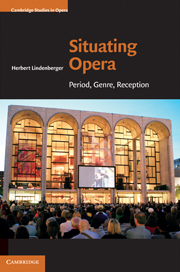Book contents
- Frontmatter
- Contents
- Acknowledgements
- Prologue
- 1 Anatomy of a warhorse: Il trovatore from A to Z
- 2 On opera and society (assuming a relationship)
- 3 Opera and the novel: antithetical or complementary?
- 4 Opera by other means
- 5 Opera and/as lyric
- 6 From separatism to union: aesthetic theorizing from Reynolds to Wagner
- 7 Toward a characterization of modernist opera
- 8 Anti-theatricality in twentieth-century opera
- 9 A brief consumers' history of opera
- Epilogue
- WORKS CITED
- Index
6 - From separatism to union: aesthetic theorizing from Reynolds to Wagner
Published online by Cambridge University Press: 05 August 2011
- Frontmatter
- Contents
- Acknowledgements
- Prologue
- 1 Anatomy of a warhorse: Il trovatore from A to Z
- 2 On opera and society (assuming a relationship)
- 3 Opera and the novel: antithetical or complementary?
- 4 Opera by other means
- 5 Opera and/as lyric
- 6 From separatism to union: aesthetic theorizing from Reynolds to Wagner
- 7 Toward a characterization of modernist opera
- 8 Anti-theatricality in twentieth-century opera
- 9 A brief consumers' history of opera
- Epilogue
- WORKS CITED
- Index
Summary
Consider the following statements, written within less than a decade of one another:
I believe it may be considered as a general rule, that no Art can be engrafted with success on another art. For though they all profess the same origin, and to proceed from the same stock, yet each has its own peculiar modes both of imitating nature, and of deviating from it, each for the accomplishment of its own particular purpose. These deviations, more especially, will not bear transplantation to another soil.
It is a necessary and natural consequence of their perfection that, without any shifting of their objective boundaries, the different art forms are becoming increasingly similar to one another in their effect on the mind [Gemüt]. Music in its highest ennoblement must become form and move us with the quiet power of antiquity; plastic art in its highest perfection must become music and move us by means of its direct sensuous presence; poetry in its most perfect development must, like music, grip us powerfully but at the same time, like sculpture, surround us with quiet clarity. The perfect style belonging to each of the various art forms is shown in its ability to eliminate their specific limits without giving up their specific advantages.
- Type
- Chapter
- Information
- Situating OperaPeriod, Genre, Reception, pp. 139 - 173Publisher: Cambridge University PressPrint publication year: 2010



